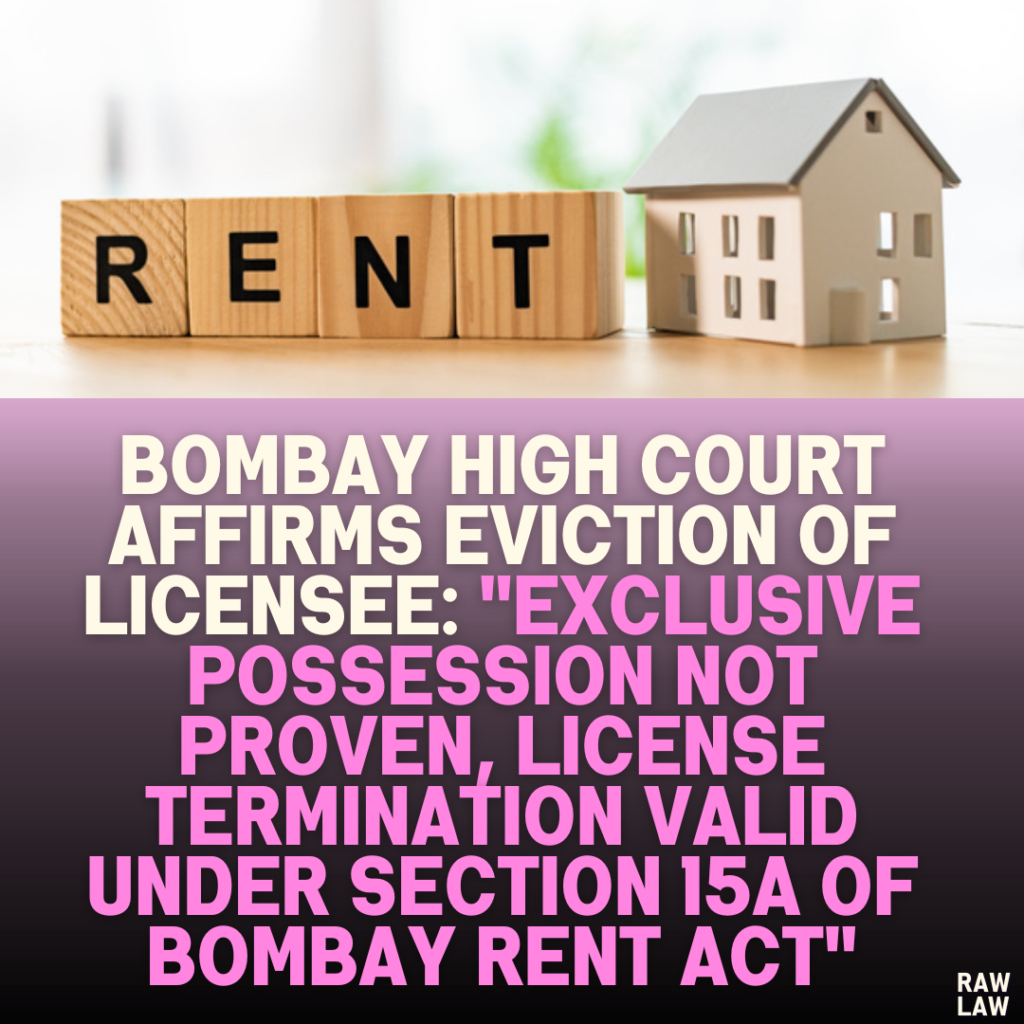Court’s Decision
The Bombay High Court dismissed the petition filed by the legal heirs of the original defendant, upholding the eviction order issued by the Appellate Bench of the Small Causes Court. The court confirmed that the petitioner failed to establish exclusive possession of the suit premises, a prerequisite for claiming tenancy under Section 15A of the Bombay Rent Act.
Facts
- Background of the Case:
- The original plaintiff, a tenant of Gala No. 5A, permitted the defendant and another individual to use portions of the premises for their businesses.
- The defendant operated two lathe machines, while another individual worked with their machinery in different portions of the premises.
- In 1977, the plaintiff terminated the defendant’s license, alleging unauthorized actions such as installing a drilling machine without consent.
- Legal Developments:
- The original plaintiff filed a suit in 1978 seeking eviction of the defendant.
- The Small Causes Court initially dismissed the suit in 1988, siding with the defendant’s claim of protected tenancy.
- On appeal, the Appellate Bench reversed the decision in 1997, ordering eviction and granting mesne profits to the plaintiff.
- Petition in the High Court:
- The defendant’s legal heirs approached the Bombay High Court, challenging the Appellate Court’s findings and seeking a declaration of protected tenancy.
Issues
- Did the defendant hold exclusive possession of the suit premises as a licensee on February 1, 1973, to claim protected tenancy under Section 15A of the Bombay Rent Act?
- Was the eviction decree justified based on the evidence presented?
Petitioner’s Arguments
- Claim of Protected Tenancy:
The defendant argued that they had occupied the entire premises as a protected tenant since 1953, making the eviction suit untenable. - Burden of Proof:
It was claimed that the plaintiff failed to prove that others occupied portions of the premises or had rights over them. - Reliance on Evidence:
The petitioner contended that the Appellate Court erred by relying on evidence not supported by the plaintiff’s pleadings.
Respondent’s Arguments
- License Termination:
The plaintiff asserted that the defendant was merely a licensee who had no rights to remain in the premises after the termination of the license in 1977. - Joint Possession Proven:
Documentary evidence, including sales tax certificates and municipal licenses, demonstrated that multiple individuals, including the plaintiff, shared possession of the premises. - Failure to Prove Exclusive Possession:
The defendant did not provide conclusive evidence to support their claim of exclusive possession, which was necessary for a claim under Section 15A of the Bombay Rent Act.
Analysis of the Law
- Section 15A of the Bombay Rent Act:
- To claim protected tenancy, a licensee must show exclusive possession of the premises (or a portion thereof, not less than a room) on February 1, 1973.
- Joint possession by multiple individuals disqualifies a claim under this provision.
- Burden of Proof:
- Since the plaintiff conceded that the defendant was a licensee, the burden shifted to the defendant to prove exclusive possession.
- The defendant failed to meet this burden, as evidence showed shared possession by other individuals.
- Relevance of Evidence:
- Licenses and permits for the operation of machines in the premises were issued in the plaintiff’s name, undermining the defendant’s claim of exclusive control.
- The defendant’s admission in a reply letter (dated September 21, 1977) acknowledged that another individual used portions of the premises.
Precedent Analysis
- Chandavarkar Sita Ratna Rao v. Ashalata S. Guram
High Court findings can only be interfered with if they are perverse or based on no evidence. The court applied this principle to uphold the Appellate Court’s findings. - Ram Sarup Gupta v. Bishun Narain Inter College
Evidence outside the scope of pleadings cannot be considered. The court ignored evidence related to another individual’s possession due to a lack of foundational pleadings. - S.P. Chengalvaraya Naidu v. Jagannath
The court rejected the petitioner’s argument that an eviction decree obtained by the plaintiff amounted to fraud, as no evidence supported this claim.
Court’s Reasoning
- Lack of Exclusive Possession:
- The plaintiff produced evidence, including municipal licenses and sales tax registrations, indicating that the premises were jointly occupied.
- The defendant failed to produce any documentation supporting exclusive possession.
- Admissions by Defendant:
- In a reply to the plaintiff’s termination notice, the defendant admitted that another individual also used portions of the premises.
- Conduct of Defendant:
- The defendant did not challenge the transfer of tenancy rights to another individual in 1981, undermining their claim of tenancy.
- Subsequent court proceedings confirmed that the premises were not exclusively occupied by the defendant.
- Finality of Previous Decrees:
- A decree passed in a related suit (S.C. Suit No. 5283/1985) confirmed joint possession by another individual. This decree, which was not challenged, further weakened the defendant’s case.
Conclusion
The High Court concluded that the petition lacked merit and dismissed it. The Appellate Court’s eviction order was upheld, with the defendant’s legal heirs directed to vacate the premises by February 28, 2025.
Implications
This judgment reaffirms the strict requirements for claiming tenancy rights under Section 15A of the Bombay Rent Act. Licensees must conclusively prove exclusive possession as of the relevant date to avoid eviction.




Pingback: Supreme Court Upholds Enhanced Compensation in Motor Accident Case: Mandates "Just Compensation" Under Section 168 of Motor Vehicles Act and Considers Future Prospects for Self-Employed Victims - Raw Law